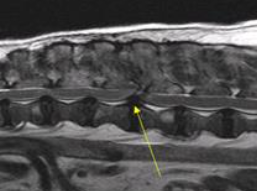Aggression and anxiety are common behavioural issues seen in pets, and they can be caused by a variety of factors, including underlying medical conditions. In this article, we will explore the percentage of pets with aggression or anxiety that have underlying medical conditions.
Medical conditions that can cause aggression or anxiety
There are several medical conditions that can cause or contribute to aggression or anxiety in pets. These may include:
Pain or discomfort
Pets that are in pain or discomfort may become aggressive as a means of protecting themselves. Pain can also cause anxiety and lead to changes in behaviour.
This patient was referred to Dr Jessica for sudden onset of fear of leaving the house and aggression when handled. Pain was noted on examination of the neck, thoracic and lumbar (lower back) spine. A neurological examination showed subtle nerve changes in the back legs.


Luckily, thanks to a swift diagnosis and specialist surgical intervention, the patient has made a complete recovery and following management of her fear of being touched, she has been discharged from SVBS’s care.
Thyroid disease
Thyroid disease can cause a variety of behavioural changes in pets, including aggression, anxiety, and fearfulness.
Neurological disorders
Neurological disorders such as seizures, inflammation or brain tumours can cause changes in behaviour, including aggression, anxiety and abnormal repetitive “compulsive” disorders.
Metabolic imbalances
Metabolic imbalances, such as those caused by liver or kidney disease, can lead to changes in behaviour, including aggression and anxiety.
Up to 60% of pets with behavioural problems have underlying diseases.
The percentage of pets with behavioural problems that have underlying medical conditions varies depending on the study and the population of pets being evaluated. In general, however, studies have shown that a significant percentage of pets with aggression or anxiety have underlying medical conditions.
- One study of dogs with aggression found that 42% had an underlying medical condition that was contributing to their aggressive behaviour.
- Another study of dogs with separation anxiety found that 60% had an underlying medical condition, with the most common being gastrointestinal disorders.
- In cats, a study of aggression found that 40% had an underlying medical condition, with the most common being pain or discomfort.
What this means for pet guardians
If your pet is exhibiting signs of aggression or anxiety, it is important to have them evaluated by a veterinarian who is skilled in and passionate about internal medicine, pain management and neurological disease.
Dr Jessica Pickett holds her memberships in internal medicine, has completed additional training in neurology, identification of pain and is sitting her membership examinations for veterinary behaviour in 2024. You can find out more about her here.
While behavioural issues can be caused by a variety of factors, including environmental and genetic factors, medical conditions should always be ruled out as a possible cause.
If an underlying medical condition is identified, treating that condition may help to improve your pet’s behaviour. Additionally, even if a medical condition is not identified, a behaviour veterinarian can work with you to develop a treatment plan that addresses your pet’s behavioural issues and improves their quality of life.
References
Dodman, N. H., Karlsson, E. K., Moon-Fanelli, A. A., Galdzicka, M., & Perloski, M. (2011). A review of the genetic basis of canine aggression. Veterinary Journal, 190(3), 278-286. doi: 10.1016/j.tvjl.2010.12.025
Horwitz, D. F., & Mills, D. S. (2009). BSAVA manual of canine and feline behavioural medicine (2nd ed.). British Small Animal Veterinary Association.
Sherman, B. L., Mills, D. S., & Taylor, K. (2008). Canine anxieties and phobias: An update on separation anxiety and noise aversions. Veterinary Clinics of North America: Small Animal Practice, 38(5), 1081-1106. doi: 10.1016/j.cvsm.2008.03.004
Landsberg, G. M., Hunthausen, W. L., & Ackerman, L. J. (2013). Handbook of behavior problems of the dog and cat (3rd ed.). Elsevier Health Sciences.
Pryor, P. A., Hart, B. L., Bain, M. J., & Cliff, K. D. (2001). Causes of urine marking in cats and effects of environmental management on frequency of marking. Journal of the American Veterinary Medical Association, 219(12), 1709-1713. doi: 10.2460/javma.2001.219.1709
